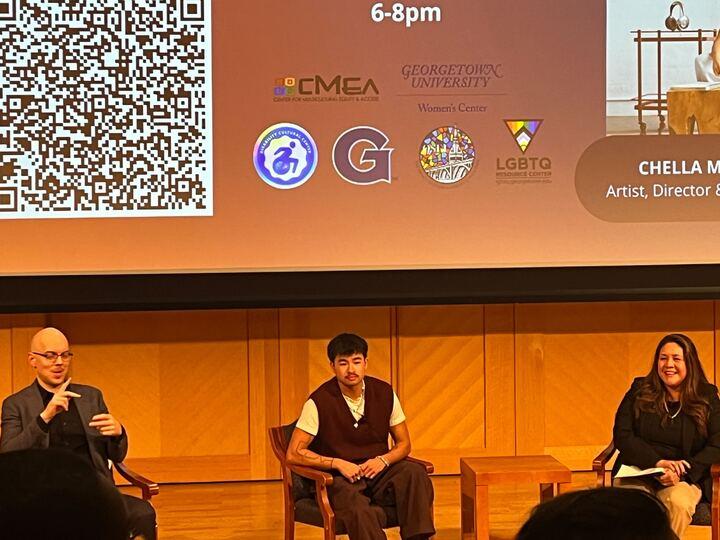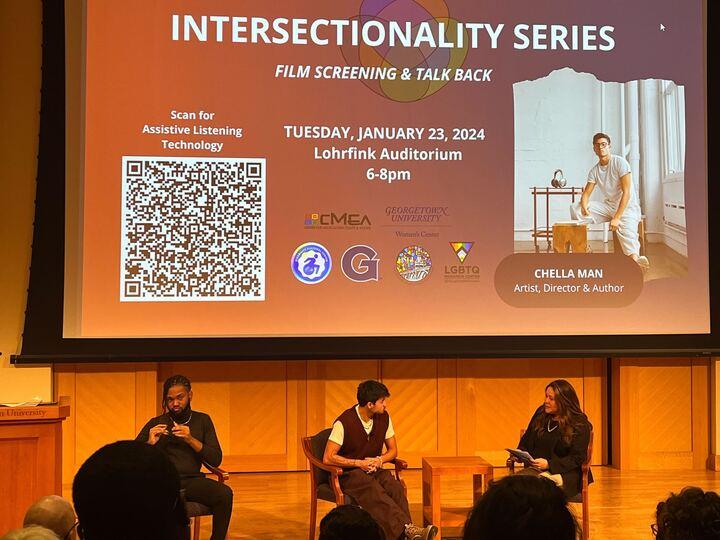Artist Chella Man visited campus for a film screening and Q&A in Lohrfink Auditorium as part of a series about intersectionality Jan. 23.
The Intersectionality Series, sponsored by the Georgetown University Athletic Department and Office of Student Equity and Inclusion (OSEI), aims to foster dialogue among students about intersectionality by highlighting the voices of experienced artists, intellectuals, activists and practitioners to foster an accepting and welcoming campus. At the event, Man, who uses they/he pronouns, showed a short film titled “The Device That Turned Me Into A Cyborg Was Born The Same Year I Was,” which details their experience with a cochlear implant.
Man identifies as Deaf, transgender, Jewish and Chinese, and much of his work revolves around the intersections of these identities. Man said this intersectionality is central to their work.
“It’s just being realistic about what people truly experience. Intersectionality is not this new, specific box. It’s almost like chucking all the boxes out the window and just being like ‘Oh, we’re all human.’ There are so many experiences that don’t fit into these preconceived binaries,” Man said at the event. “Human beings are so complex and multifaceted, and we all have different stories to tell.”
Man got his start on YouTube, creating videos about his exploration of his queer and deaf identities. In response to several audience questions, they discussed how they dealt with making art as a public figure, especially as an openly transgender individual who shared their transition story on the internet.
“With YouTube specifically, it was a very interesting experience, because I actually began posting because I wanted, for myself, to organize my documentation,” Man said. “I think it really made me realize that I’m not the only one and there are actually people out there who are experiencing the same things that I’m experiencing. It was really empowering and validating.”
This event marked the third in the Intersectionality Series after two book signings with Katie Barnes, a journalist who discusses sports and gender, and Georgetown professor Julia Watts Belser, a rabbi and Jewish scholar.

Amy Kenny, the director of Georgetown’s Disability Cultural Center (DCC), emphasized that the Intersectionality Series hopes to create a community that fits the needs of all of its members.
“The series seeks to create an ongoing dialogue on campus about intersectionality as an embodied ethos and practice, by amplifying artists, scholars, practitioners and activists with relevant lived experience and expertise,” Kenny wrote to The Hoya. “Throughout the series, we hope to cultivate an inclusive, accessible community invested in collective care and flourishing.”
Riley Jelenick, the associate director of Georgetown’s LGBTQ Resource Center, described the series as a way to incorporate discussions of identity into the interpretation of scholarship.
“The intentional thought behind this series is really to highlight how intersectionality exists already, and how it plays out in peoples’ day to day lives with their identities,” Jelenick told The Hoya. “So, allowing members of our community to see that this isn’t something that just OSEI talks about, and this isn’t a new conversation by any means.”
Jelenick added that the series is set to continue into next year and beyond, aiming to host two events per semester.
Throughout the event, Man communicated using both spoken and sign language. They emphasized the importance of the Deaf community in their life and spoke about how the experience of losing their cochlear implant inspired the film.
“For ten days, I was actually immersed in complete silence, traveling with a bunch of people that I was actually not that familiar with. I kind of expected to feel very drained and I was really scared and terrified at first, but I realized it was actually so much more liberating,” Man said. “At the end of the day, I had more energy than I even realized or anticipated. So I began to question how much I actually wanted to use my cochlear implant, and how much access to sound I actually wanted.”
While he said that he was interested to hear how the hearing community experienced the film, Man stated his goal was to connect and communicate with the Deaf community.
“It’s a film that I made for my community, it wasn’t for the consumption of hearing people,” Man said. “I’ve been very interested to understand how hearing people receive it, but I showed one of my closest friends, who’s also Deaf and trans, when it was the final cut, and he just started crying. We had very similar life experiences growing up in a hearing family, having these devices to survive in a hearing environment. I just felt like that’s all I could ask for. I just felt satisfied to see him feel what I wanted the film to provoke.”
Man frequently returned to the topic of their relationship with rest, particularly in the context of activism. Much of their art is related to issues of social justice, and they commented that finding time to rest can be difficult to balance with that work.
“We don’t exist to fight. We have to fight, but we exist to rest. That’s the goal, right? We exist to be free,” Man said. “I think within Western culture, in Western society and activism spaces, a problem I’ve seen time and time again is that a lot of marginalized individuals are expected to put their lives on the line for these causes. But that is the exact opposite of what is powering.”
“I think our self-preservation and our existence is what we’re fighting for. So, to put that on the line as a sacrifice, it feels like we’re giving up our power,” Man added.
Man said that it can be challenging to create unconventional art in a capitalist society, and to strike a balance between creativity and a need for income. He urged attendees to continue making their art despite those challenges.
“It doesn’t matter because you’re doing it for you. And the validation and satisfaction you will get from that will always be worth it,” Man said. “I’ve often been told that my energies and my work are too niche to have an audience. And if I let that stop me, I wouldn’t be sitting here. So I would say, just follow your gut. Don’t do it for other people. Do it for you.”















